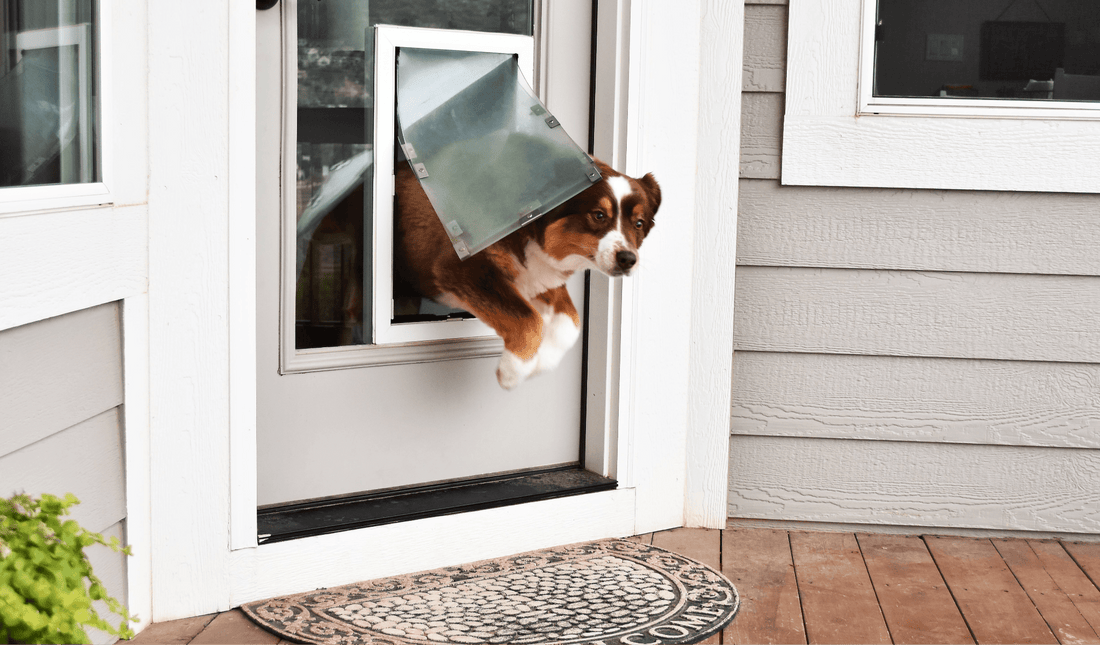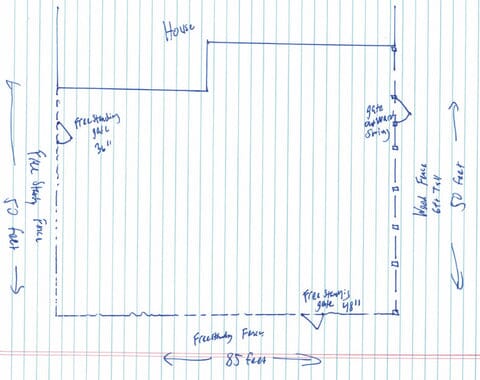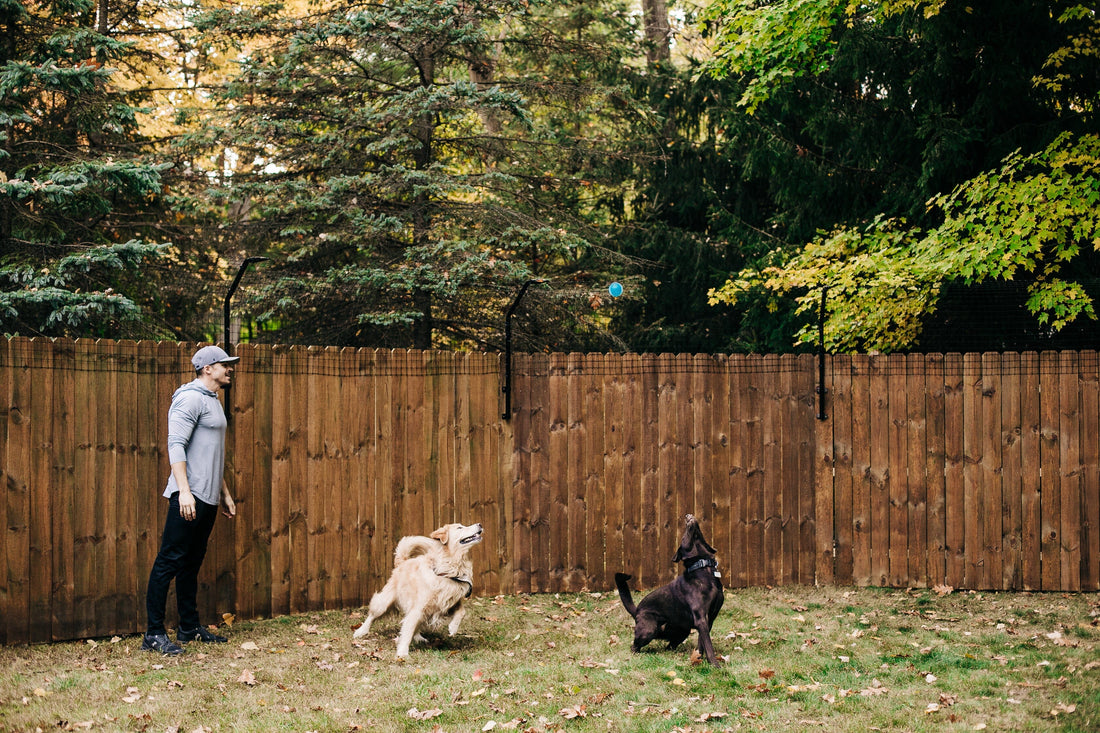As the saying goes, “Dogs are man’s best friend.” However, we all know dogs that are more interested in chasing wildlife, hanging out in neighbor’s yards, or making new friends down the street when they go outside.
For dogs that are determined to escape the yard and familiar with more interesting landscapes, finding ways to keep them contained safely can be challenging – and sometimes expensive! Many dog owners consider wireless invisible fencing as a containment solution due to its affordability, but how do you know if an invisible electric fence is right for you?
What is an Electric Dog Fence System?
When it comes to invisible electric pet fencing, there are two main options for dogs:
- Wireless Dog Fence. An invisible wireless dog fence commonly uses radiofrequency to create a barrier, although some options may use GPS. The transmitter is centrally located and creates a dome-shaped “enclosure” set to a specific range that forms the perimeter. Your dog wears a perimeter collar that communicates with the transmitter, and as the perimeter collar moves toward the set boundary, it will give a warning signal to let the dog know it is approaching the boundary. If the dog continues and crosses the electric fence system’s boundary, it receives a static shock correction.
- Underground Dog Fence. An invisible in-ground dog fence creates a boundary using an electric wire buried underground. Although this option works very similarly to a wireless fence, the boundary wire can be placed more freely for a more customizable boundary. Rather than communicating with a transmitter, the collar connects to the wired electric boundary.
Pros and Cons of Invisible Dog Fence Solutions
Advantages of an Electric Dog Fence System
When researching your options for invisible wireless dog fences or wired in-ground dog fences, there are several pros and cons to consider. The most commonly cited advantage for both types of electric dog fences is that they are invisible. An invisible electric fence does not block a picturesque view or affect the yard’s aesthetics.
Although the cost of invisible dog fences varies depending on your needs, the overall cost tends to be less than traditional fencing for most yards, especially for large yards. For many pet owners, this can be a deciding factor and perceived benefit of an invisible electronic dog fence system when selecting the best containment solution for their dog.
Wireless Fence Benefits

If you stick with a wireless solution, you even have the option to travel with your electric dog fence! This is great for camping, weekend stays with friends or family, or long-term vacations with your dog in tow. A wireless system requires a transmitter, an outlet, and a receiver collar. Most can be easily packed, moved, and set up at a new location. For the fence to be most effective for travel, your dog should be trained to recognize the system’s warning signals rather than a physical boundary perimeter.
In addition to these travel perks, an electronic dog fence system is generally very easy to set up on your own. Most systems do not require professional installation. If you have any questions during your installation and setup, many providers also include accessible online or phone support.
Underground Wired Fence Benefits

One added benefit to an in-ground invisible electric fence solution is that the boundary line is completely customizable. This is great for odd-shaped yards, as the in-ground wire can run along the entire yard’s perimeter regardless of its shape. Underground invisible fences also give you the option to “exclude” areas of the yard where you don’t want your dog to enter. This could be your vegetable garden or a pool area, for example.
An underground invisible electronic dog fence system is also great for large yards. There is no constraint on the distance the wired barrier can run, so a wired fence works well for large yards in addition to odd-shaped ones. Any area larger than an acre would benefit from a wired system over a wireless system.
Disadvantages of Electric Dog Fences

As with any barrier solution for containing a dog, invisible dog fences also have some drawbacks. The first is that it’s invisible! This one is a bit of a double-edged sword – while it is great to have an invisible fence that doesn’t block your view, it will not prevent intruders from entering the yard. Wild animals like raccoons, foxes, deer, and coyotes can all still cross the electric dog fence system unhindered, as can other neighborhood cats and dogs, including strays.
This also means that your dog can see everything going on around them. Some dogs become frustrated when they can see other animals and people nearby but can’t run over to greet them. It can be especially difficult for some dogs to be able to see other neighbor dogs running and playing, knowing that they are not able to join in.
Additionally, if the power goes out, so does your electronic dog fence system. This could prove problematic in an area with frequent power outages. Many systems can be hooked up to a backup battery for power outage events, allowing the system to continue to work if you lose power. However, these backup batteries can be an added expense to the system that you may not have anticipated.
Lastly, in order for the fence to be effective, your dog will most likely be zapped (ouch)! This can create discomfort to the animal on a frequent basis.
Wireless Fence Drawbacks
Radiofrequency wireless dog fences typically have a limited range that covers less than one acre. They only create a circular shape with the transmitter in the center, making some yards difficult to encompass with an invisible electric fence. This is especially true for small, odd-shaped, or long and narrow properties. They are also dependent on the perimeter collar functioning properly – and ensuring you remember to charge it.
In-Ground Wired Fence Drawbacks

Because an underground electronic dog fence system uses a physical wire, it tends to have a more involved installation process. This is especially true for large yards, as the wire needs to be buried underground. These systems also tend to have additional maintenance compared to wireless options. The underground wire can break and require repair.
As you can see, electric dog fences have advantages and disadvantages, like nearly any pet containment system you might come across. When weighing the pros and cons, it is best to do so with your own pets in mind. Are they easily trained, or are they headstrong and independent? How is their prey driven? Do they get excited and run to greet neighbor dogs or cats nearby?
How Much Does an Invisible Dog Fence System Cost?

There are many factors that can influence the total cost of an electric dog fence. The first is whether you decide to purchase a wireless invisible fence or a wired in-ground invisible fence. Generally speaking, wireless dog fences tend to be more affordable, with systems ranging in price from around $150 up to $600 or more. However, the average cost of a wireless invisible electric fence is about $250.
Underground invisible fences tend to be more expensive, with systems ranging in price from about $300 at the lower cost to about $1,200 for the system alone. Most of the additional costs associated with an in-ground electric dog fence system are related to the size of the yard or the total length of fencing wire required.
Next, you will need to decide if you are able to install the system yourself or if a hired professional will be required. Because wireless systems use radio frequency to create a barrier instead of a physical wire, professional installation is not typically necessary. Wireless dog fences tend to be very DIY-friendly for the average pet owner.
Many in-ground wired dog fences can also be installed without professional assistance – you can find several DIY options online, for example. However, many invisible electronic dog fence system companies offer professional installation services. Depending on the size and shape of your yard, the quality of the electric fence, and the terrain, the installation cost can vary greatly.
According to online price estimators, in-ground electric dog fences can range in cost from under $1,000 to over $1,900, including installation. However, anecdotal evidence suggests that the wired invisible electric fence, including installation, can be much higher than this. For example, covering approximately three acres may cost up to $2,500, and larger yards of five to ten acres could easily cost up to $5,000 or more.
Hidden Costs of an Electric Dog Fence System

The cost of invisible electric fencing above is for the base system only, with and without installation services. With many systems, you may find additional costs associated with the fence. The largest added expense is the training required to teach your dog about the new electric fence.
Some premium providers offer training services in addition to installation services. This can easily add up to $500 or more to the overall cost of the invisible electronic dog fence system. If your system provider doesn’t offer training services directly, you can opt to hire a local dog trainer. The cost of a local dog trainer will vary depending on the trainer’s skill, experience, rates, and availability.
Alternatively, many pet owners choose to take on training themselves. This can be a great bonding experience for you and your dog, but it will take time. Most sources recommend starting training slowly by walking your dog on a leash near the invisible electric fence boundary (with visible flags in place to start) in regular, short sessions to introduce it to the electronic dog fence system. Gradually, increase the training time (and remove the flags). This process should be done daily and typically lasts several weeks before the dog can be free in the yard. Even then, supervision is still strongly recommended.
Other expenses you will want to plan for include additional receiver collars if you have multiple dogs and replacement batteries for the receiver collars. The average cost for a receiver collar is $105. Batteries should be checked regularly and are typically replaced every three months with everyday use. Some receiver collar brands require specialty batteries that may last longer but are also more expensive.
You may also consider purchasing a backup battery for your electronic dog fence system, especially if you live in an area where the power frequently goes out. In the event of a power outage, your system can continue to function if hooked up to a backup battery. This is true for both wireless and wired electric dog fences. Backup batteries cost anywhere between $75 to $150, depending on the size of the battery.

Another hidden expense specific to the in-ground invisible electric fence is a surge protector. It is known that the underground electric wire of an in-ground system attracts lightning strikes. So, if you live in an area where thunderstorms are common, it might be a good idea to add a surge protector to your electronic dog fence system! The additional cost of a surge protector is typically between $30-50.
Effectiveness of Electric Dog Fences
As you know, dogs come in all different shapes, sizes, and athletic abilities. But they also all have their own unique personalities and interests! A containment solution that works great for one dog may be ineffective for another. Because of this, no single electric solution is 100% effective for all dogs.
The effectiveness of either a wireless or wired dog fence will also depend on the amount of training provided. Because there is no physical barrier in place as a reminder, several training sessions are required to help your dog understand where the barrier is located and how the electronic dog fence system works.
This is especially important if you intend to travel with your wireless dog fence. When training your dog to respect the boundary, you want to be sure that it understands the signals of the receiver collar rather than a physical boundary line.
Dogs with high energy levels or a high “prey drive” tend to beat the invisible electric fence, bolting right through the barrier at the sight of a wild animal, their best furr-iend next door, or their favorite delivery person.
Statistics suggest that an invisible dog fence system is effective about 60-70% of the time. This implies that although an invisible dog fence may be a deterrent for many dogs under normal circumstances, if the incentive to cross the electric barrier is high enough, a static shock correction will not stop them from crossing the barrier and escaping the yard.
Other Factors that may Impact Effectiveness
While training and your dog’s personality are the main factors of how effective an invisible electric fence will be, other variables can also impact the effectiveness of either a wireless or in-ground wired electronic dog fence system:
- Power Outages. For both a wireless and wired system, a power outage can cause the invisible electric fence to shut off, as both rely on electricity to work properly.
- Receiver Collar. It is important to note that the receiver collar should be worn snugly around your dog's neck. For the static shock correction to work most effectively, the collar's contact points should be touching the skin. Collars should not be worn loosely, as this may not allow for a good connection.
- Collar Batteries. It is important to check the receiver collar’s batteries regularly. If the battery dies, the collar no longer communicates with the transmitter or in-ground wire of the electronic dog fence system, allowing your dog to walk effortlessly through the boundary. Particularly intelligent dogs may even learn how to drain the collar battery by sitting in the “warning zone” until the collar stops giving the warning signal.
- Transmitter Location. When it comes to a wireless electric dog fence, the transmitter needs to be placed strategically to prevent any “gaps” or “breaks” in the barrier. Transmitters should be placed on the first-floor level of the house only. It should be located in an area free of large metal objects such as cars, appliances, or electric panels. Other metal objects, such as a metal roof or fence, may also interfere with a wireless fence.
Landscape. Large trees and hills in the yard can block the radio frequency signals for an electronic dog fence system, creating gaps along the barrier. If your yard has several large trees or is not flat, an in-ground invisible electric fence will better provide a complete perimeter barrier.

Invisible Dog Fence Alternatives
As you can see, the cost of an invisible wireless or wired dog fence can vary depending on many variables. These include the size of your property, the shape of your property, the number of dogs you have, and whether you choose to install the system yourself or hire a professional. Although an invisible electronic dog fence system may be a great, affordable containment solution for some dogs and dog owners, it may not be for everyone. So what alternatives do you have?
- Supervision on a long line. If installing a barrier fence is not an option, you can give your dog some additional freedom on a leash by using a long line. This is a leash that is typically anywhere between 25 to 50 feet in length. Although this option gives less reign than an electronic dog fence system, it still gives your dog some freedom to run and play while secured to a leash.
Zipline or tie-out with a harness. If you cannot be outside with your dog and use a long line, consider a zipline or tie-out. A zipline is installed between two points overhead. Then a special leash is secured to the zipline at one end and your dog’s harness at the other. A tie-out is similar. However, rather than a line above, it uses an anchor point in conjunction with a special long line. Unlike an electronic dog fence system, these options should always be used with a harness rather than a collar to prevent injury.

- Smaller enclosure or kennel. If you prefer to allow your dog to have an outdoor space that does not require a leash or an invisible electric fence, then building a smaller enclosure or kennel can be an excellent option for keeping it safely contained. While a kennel may not give your dog the freedom to roam or explore the entire property, it is a safe space where your dog can spend time outdoors.
- Traditional fencing. Of the alternative options listed, this one is likely to be the most costly, but it will also provide the largest area and has some added benefits for you as well! Unlike an electronic dog fence system, some traditional fencing options allow for added privacy from neighbors and can create a cozy backyard environment for you and your dog! Fences come in various styles, heights, and materials, so you can choose an aesthetically pleasing option that provides a safe barrier for containing your dog.

- Existing fence modification. While you can’t alter an electronic dog fence system, you can modify several types of existing fences to keep your dog contained. If your yard already has a traditional fence of some kind and your dog is still finding a way out, several “dog-proof” solutions and products are available that work with your existing fence to help prevent escapes. To determine the best option for dog-proofing your fence, you will first need to examine exactly how your dog is escaping. Is your dog digging underneath the fence, squeezing its way between fence pickets, leaping over the top of the fence with ease, or scaling the fence itself?
You have to teach your dog the rules and hope it listens to them when using an invisible electric fence, as the electronic dog fence system likely won’t be effective if you don’t train your dog. However, with other fencing options, you can generally fix escape issues. A quick internet search will provide you with an extensive list of dog-proof fencing ideas for any given method of escape:
- For digging underneath a fence, you can install “L footers,” which create an “L” shaped barrier around the bottom perimeter of your fence, typically using wire mesh or a screen of some kind. Another option is to create a channel along the bottom of your fence and then fill it with difficult-to-dig-out gravel – or concrete for devoted escape artists. Some dogs may even be deterred by certain landscaping, such as thorny plants or thick shrubs. These plant types can come in handy if you’re trying to create a visible barrier with an electronic dog fence system.

- If your dog is squeezing its way between wide-gap fence pickets, finding a solution that covers the gaps is ideal. This can be wire garden mesh, clear acrylic panels, or any other material that can be added along the bottom of your fence. There are even oversized collars available to stop your dog from pushing between pickets.
- For great jumpers that easily leap over the top of the fence, you may consider extending the overall height of your fence by installing a fence topper extension. With a dog-proof fence topper, the height of your fence can be easily extended to prevent your dog from jumping over. If you find that your dog isn’t trying to jump over without the topper and is listening remarkably well to your commands, you might want to consider trying an invisible electric fence.
- If you have a climber, finding ways to keep it safely contained can be a bit more difficult. But rest assured that there are options for these persistent escape artists as well! One common solution is to install “coyote rollers” on the top of your fence. These rollers are a perk of using a physical fence rather than an electronic dog fence system because they may also stop animals from getting into your dog’s enclosure. Rollers were designed to keep coyotes out of a fenced area. Because coyotes and domestic dogs are anatomically similar, rollers may potentially work to keep some climbing dogs inside a fenced area. However, this solution may not work for all dogs.
- Another option for climbers is a fence topper system that prevents them from getting over the fence altogether. Rather than extending the height of the fence only (which they may still be able to climb), fence extension systems are available with a curved top that stops the dog’s forward momentum and prevents it from climbing over the top of the fence.

Let Dog Proofer Help You Create an Escape-Proof Fence
At Dog Proofer, we have designed a variety of humane solutions for dogs escaping under, over, or through a traditional fence of nearly any material or style. While we don’t specialize in electronic dog fence systems, we do have other fence solutions designed to keep your dog safe and happy.
With the help of our design team, you can create a fence from scratch or modify an existing one to create the perfect pet oasis. We have improved our patented products 19 times over the last 20 years because we want the very best for you and your dog. Additionally, our high-quality fences have undergone saltwater tests, proving they can withstand the harshest conditions.
If you’re ready to create a safe space for your dog, reach out to our planning engineers. We look forward to hearing from you!
To learn more about our dog fence solutions, please visit DogProofer.com.





